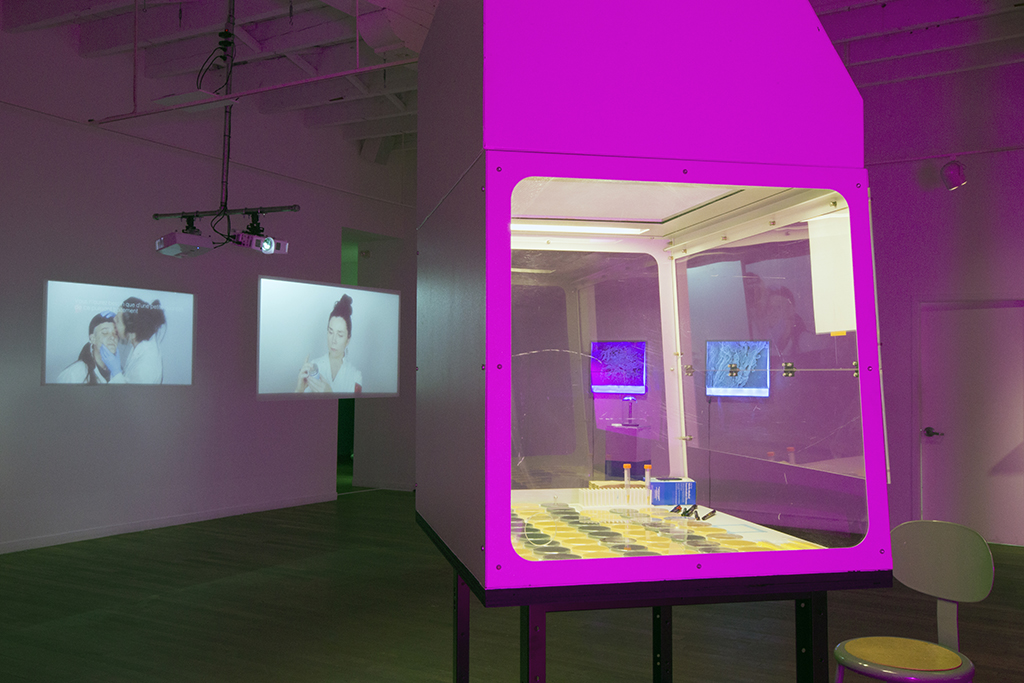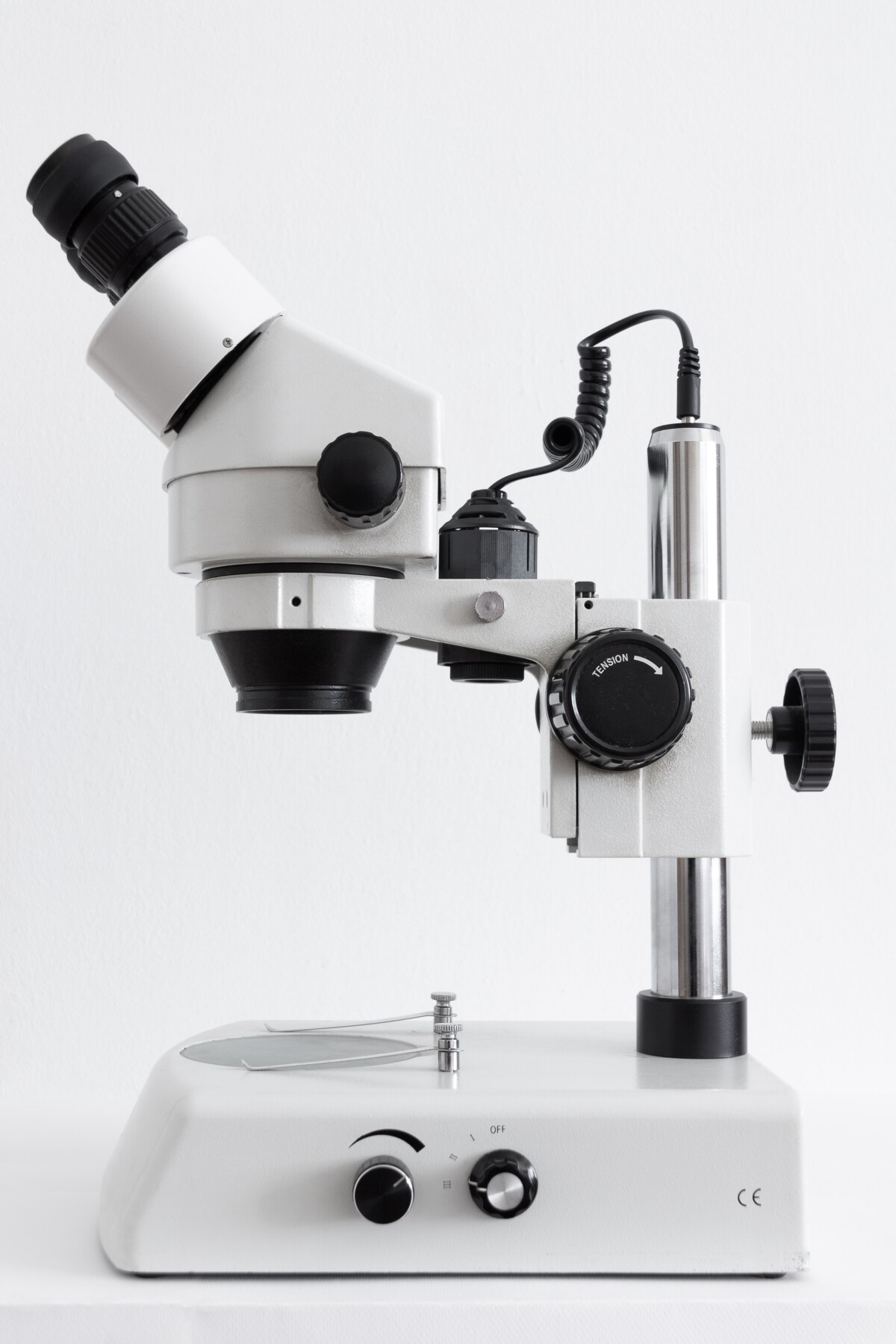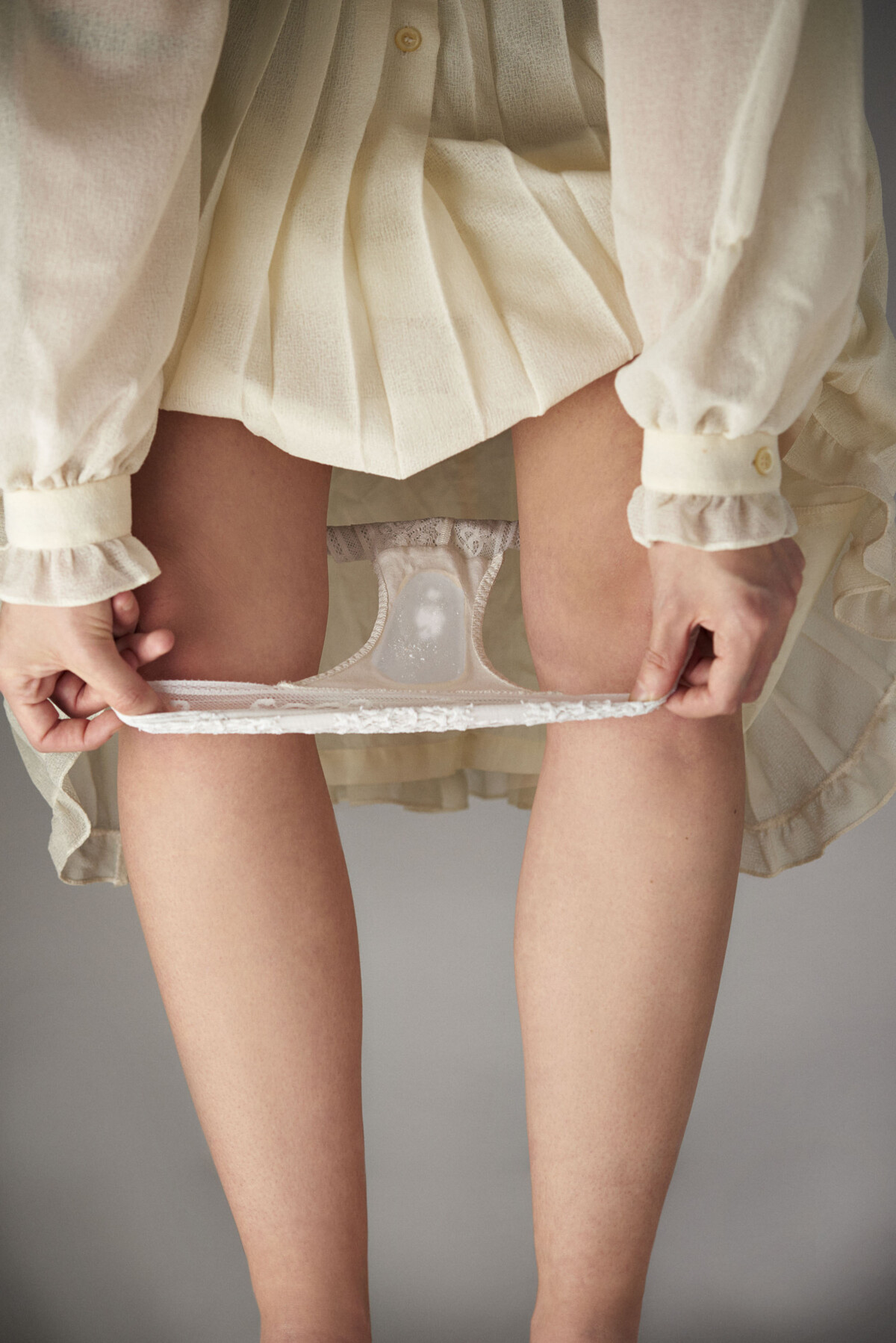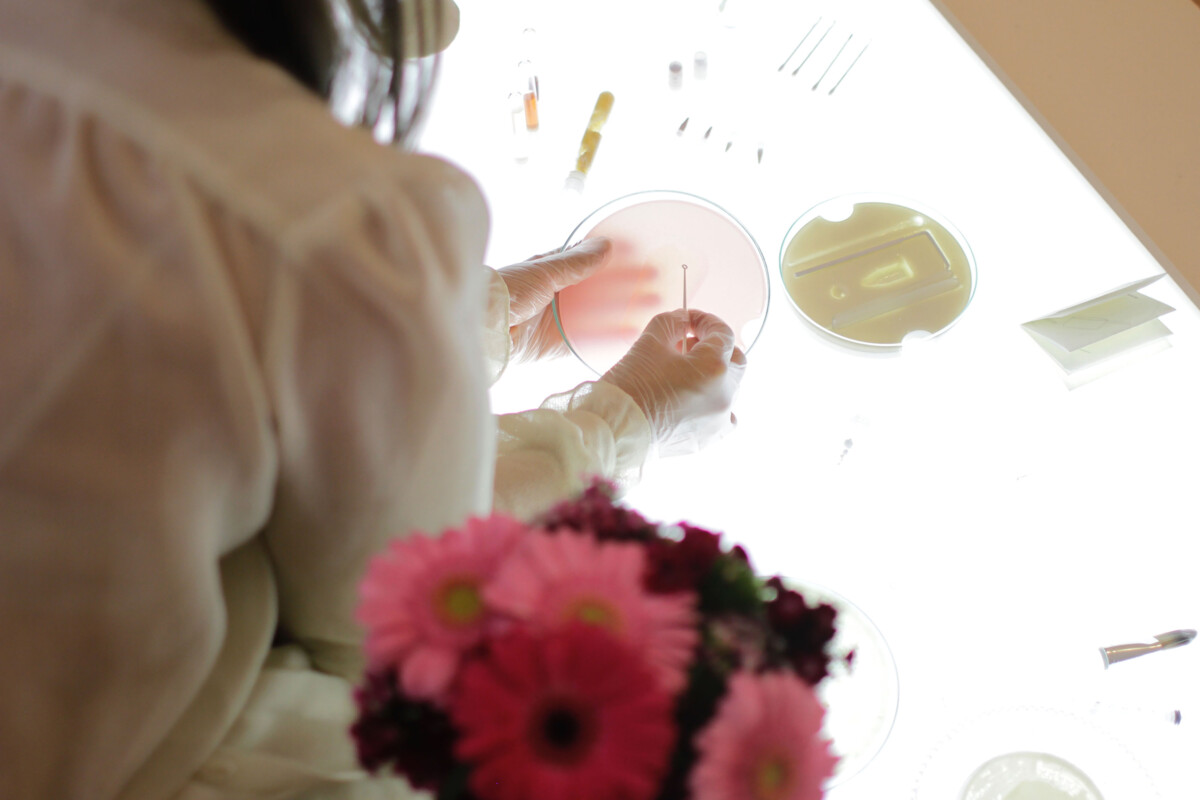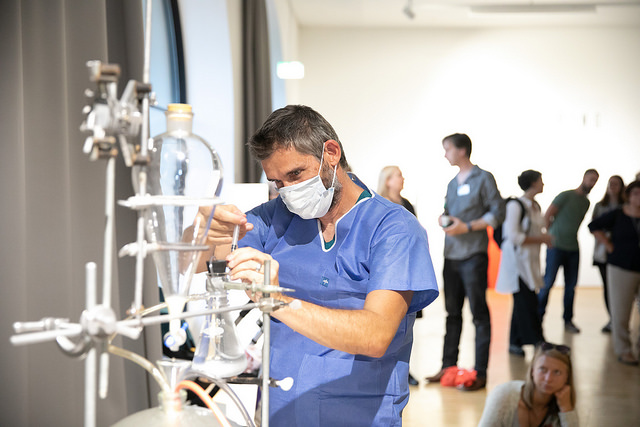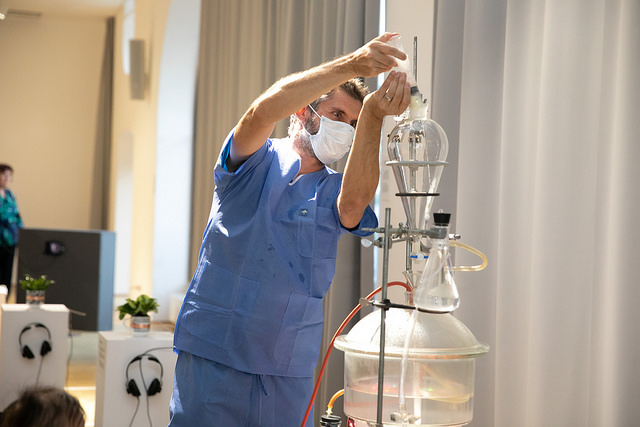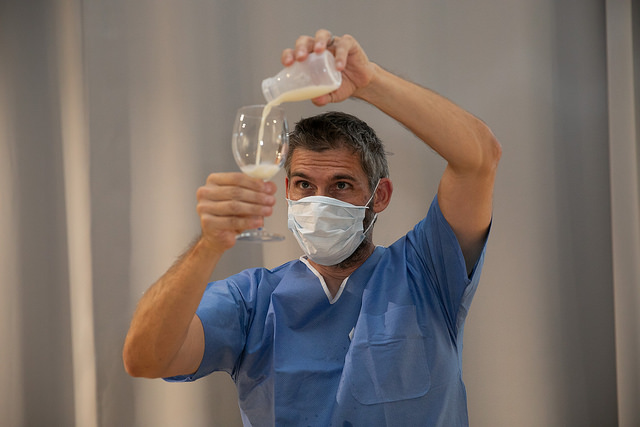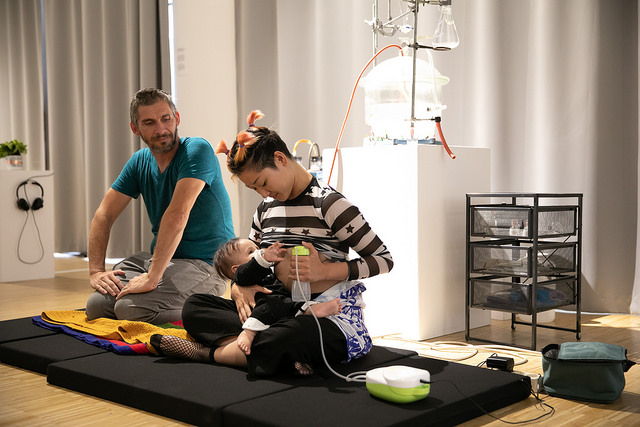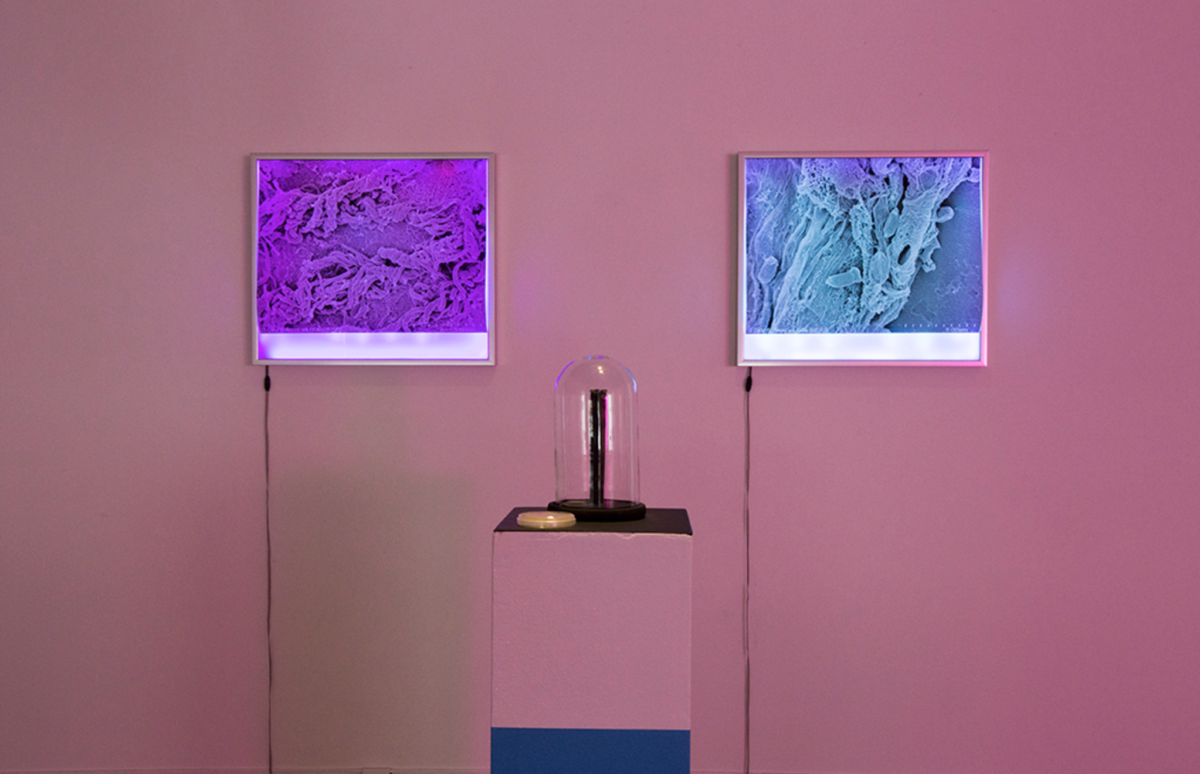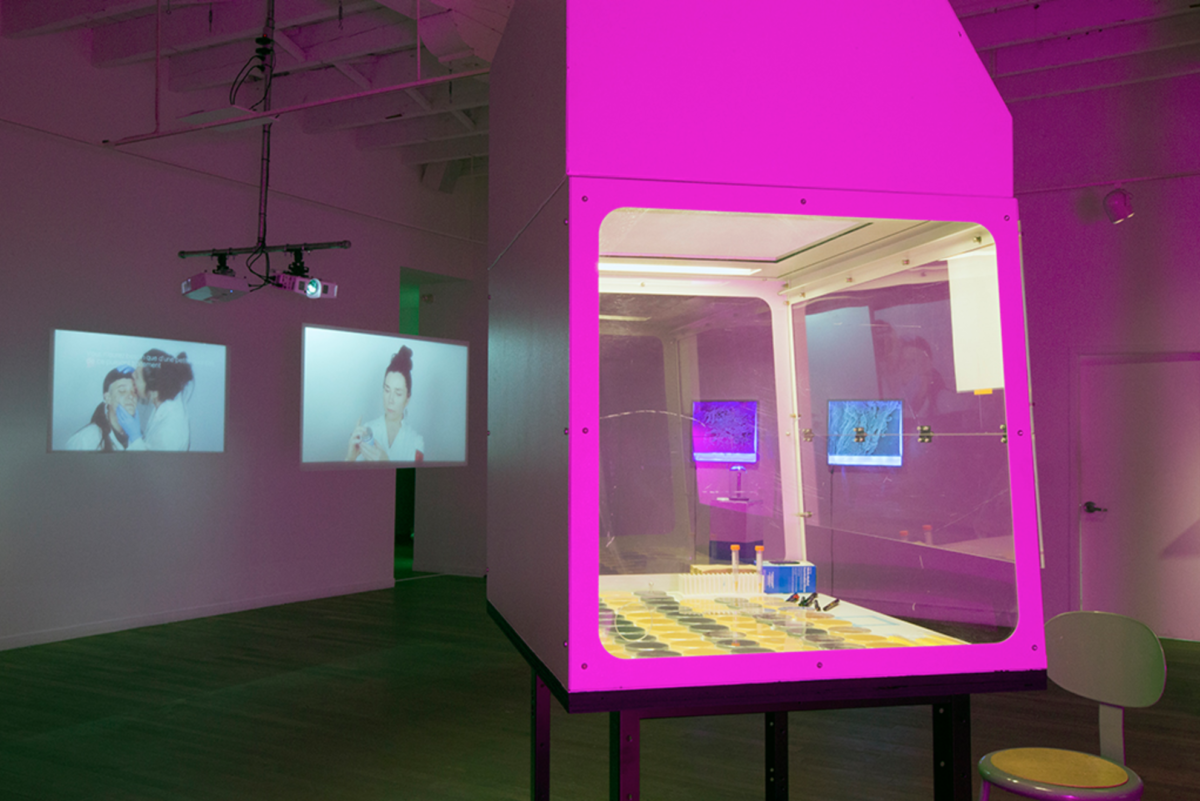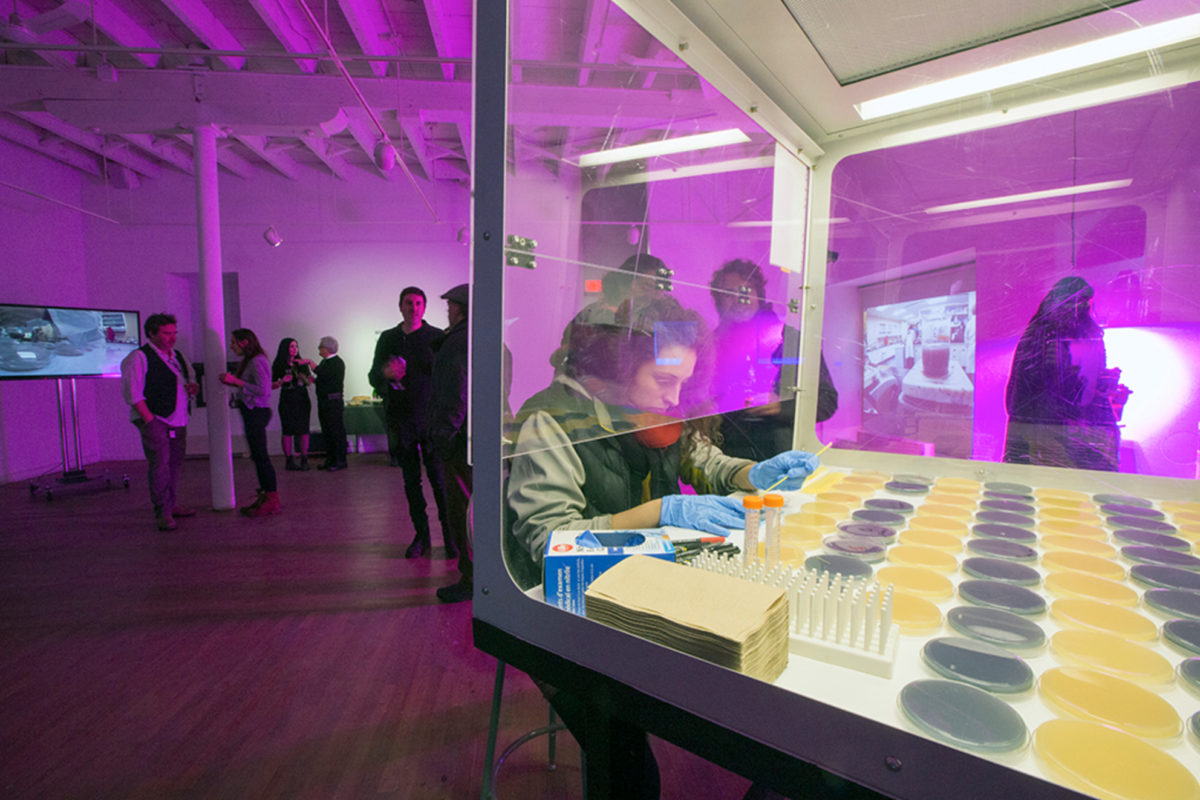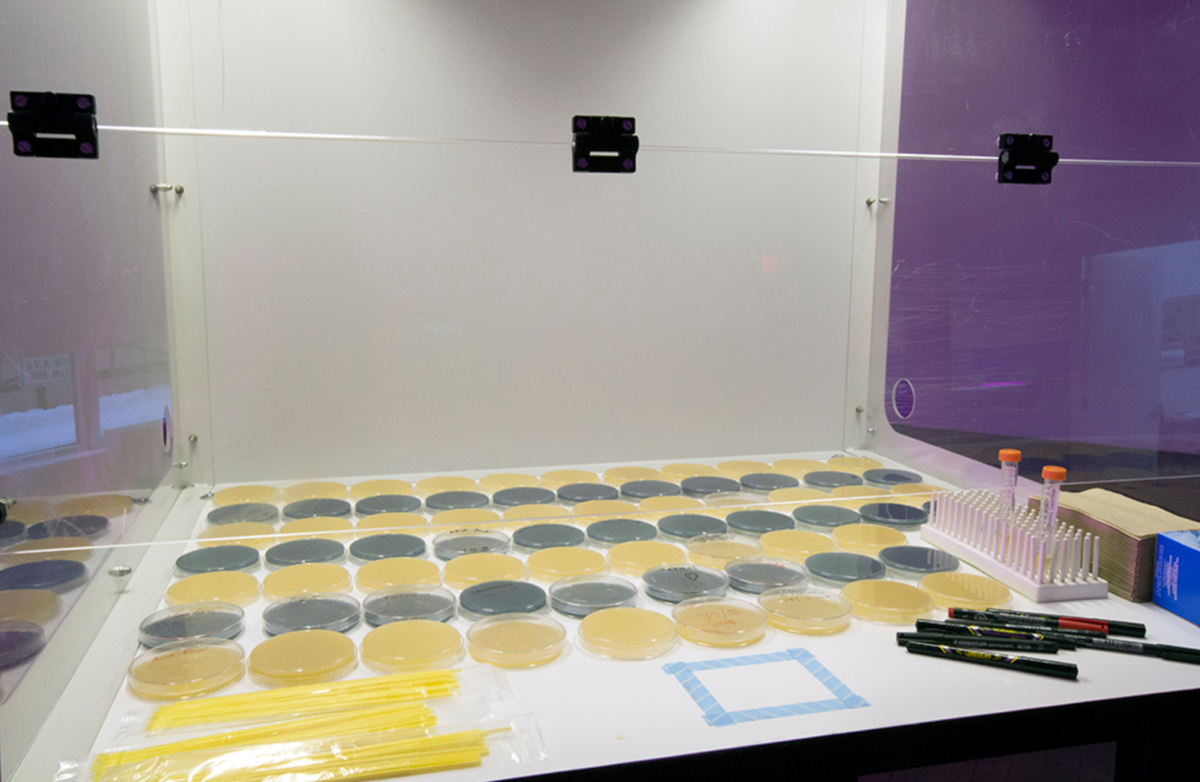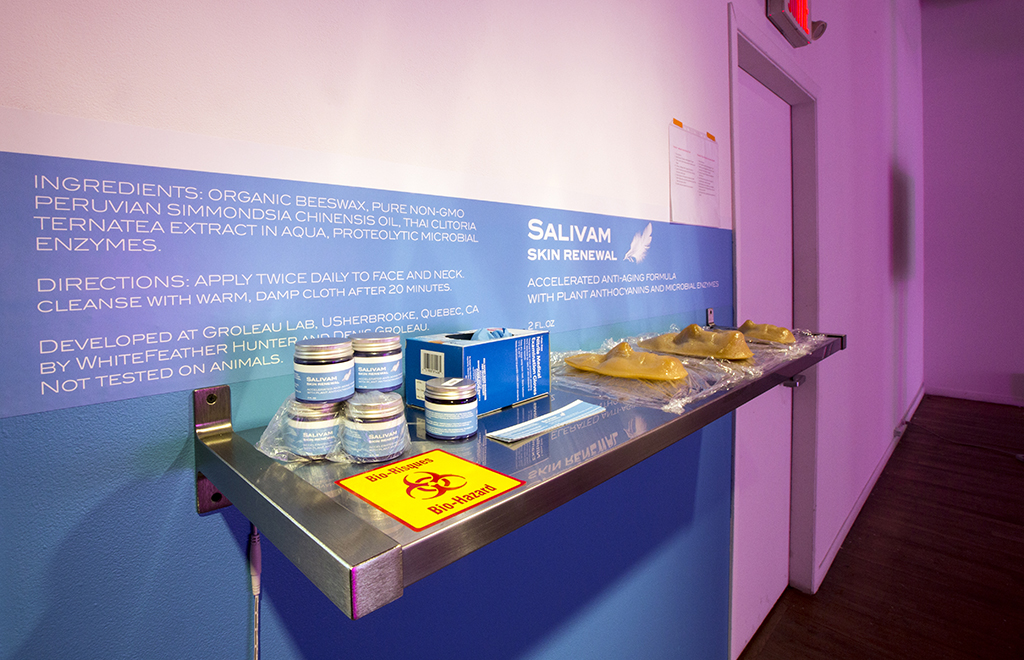DIYBIO AND EMPOWERMENT : INVISIBLE POWER AT HAND
The following text takes as its starting point my visit to Ars Electronica last September where, it seemed to me, bio-art had a strong presence, one would almost have thought it was a sub-theme. Following this observation, two projects in particular have made their place in my art-science reflections: Future Flora by Giulia Tomasello and Microbiome Rebirth Incubator by François-Joseph Lapointe and Marianne Cloutier. The questions of empowerment and the possibility of taking power over one’s own body make them projects where science opens a way of communication with the outside world. Similarly, Salivam by artist WhiteFeather Hunter, who was in research-creation residency last year at Sporobole (in collaboration with the Université de Sherbrooke), is helping to build bridges between a hermetic science and a form of DIYbio appropriation that would break disciplinary boundaries.
Lost in the 3rd basement at Ars Electronica
Last September I went for the first time to the famous Ars Electronica festival, the oldest of the new media art events – the very first edition took place in September 1979, which places it at the dawn of the mid-life crisis! In Ars I saw more than I thought I could see. The scale of the event is difficult to predict, and it is almost impossible to discover everything without scanning at certain times. In any case, it is absolutely impossible to attend the entire conference program. So much so that one wonders – at least that’s the question I asked myself – how many different target audiences the event is aimed at? Five, ten, fifteen? Because to create such overlaps of activities, you have to be very confident in your ability to fill the rooms. From my questioning follows this observation: several audiences are indeed targeted by the entire program. The usual public of media art of course, but also a more family audience and, at the opposite end of the spectrum, a very specialized audience interested in innovation and the world of start-ups, research and university creation as well. I say “opposite the spectrum” but in reality, by the way the projects are presented and their very dynamic presentation, the event succeeds in mixing these audiences in a remarkable way. Already by blurring the lines between the nature of projects, by associating works, demos and experiments in the same space, by multiplying presentation spaces as well, and by arranging meetings and promiscuity between new media works and technological products – a slightly riskier, if not cavalier, strategy – we can conclude that audiences do not have too much choice but to mix. There is certainly some good and some not so good in this way of doing things. It depends on our positioning: rather purist? Inclusive? Undecided?
In this labyrinthine and immense place that is PostCity – an old postal sorting, a splendid industrial building, vast and complex – there were therefore many exhibitions alongside each other. First of all, part of the thematic exhibition was presented on the ground floor, with most of the “maker faire” exhibitions / art-science experiments / start-ups / R & D technology, as well as one of the Campus Ars Electronica exhibitions, bringing together several research-creation micro-expos from several universities around the world. The Montreal Hexagram network – including Concordia University, Université du Québec à Montréal (UQAM) and Université de Montréal – had a strong presence this year. I’m taking a 30-second breath here to make it clear that I’m not going to make a detailed presentation of Ars Electronica 2018 or even try to clarify its organization chart of activities and exhibitions. Not only am I not sure I can do this without flatly reproducing the content of the printed program, which would be pointless, but we would also lose that sense of an abundance of confusion – which I am currently trying to convey – and which is much more faithful to reality than any detailed dissection of what was presented there. As I sometimes say: “this is not about the food, it’s about the mood” – free interpretation here. Do not forget that my comments are also those of someone who is going there for the first time. I suppose that after ten years of visits from Ars Electronica, you sharpen your sense of direction and learn to read between the lines of the program.
The theme of this 39th edition was “ERROR – The Art of Imperfection”. Beautiful theme. But is it even possible to create a real thematic cohesion within the framework of such a vast event? What I saw made me doubt it, at least in terms of exhibitions (I had the impression that there was a better resonance with the conference program though). That said, I also had the feeling – and I’m not alone – that some kind of informal bio-art sub-theme was emerging from the lot, haunting PostCity’s basements. On the floor called the “bunker”, which seemed to be the 2nd or 3rd basement of the building, there were several works whose bio-art affiliation was undeniable. And the deeper you went into the bowels of the building, the more strange the works became, I think in particular of Marco Donnarumma‘s Amygdala. Curatorial choice? Probably. Sensitivity to scenography certainly, which is required in any case by the industrial architecture of the place and its particularities, not always accommodating for the works presented.
But bio-art was not just hidden underground. They were on the main floor of PostCity in broad daylight, as well as in the satellite exhibitions that could be visited throughout the city. Two projects in particular caught my attention: Future Flora by researcher and interactive designer Giulia Tomasello was part of the 2018 Starts Prize presented on the ground floor of PostCity; and Microbiome Rebirth Incubator by François-Joseph Lapointe and Marianne Cloutier, presented as part of the exhibition “Taking Care” by Hexagram, at the KunstUniverstät gallery. Several projects caught my attention throughout the event, but in the context of our art-science reflections, I perceived a resonance between these works; as well as with the Salivam project of the artist WhiteFeather Hunter who was in research-creation residency at Sporobole (in collaboration with the Université de Sherbrooke) last year, from fall 2017 to fall 2018 – and who was also part of the “Taking Care” exhibition, where she presented the project Aseptic Requiem.
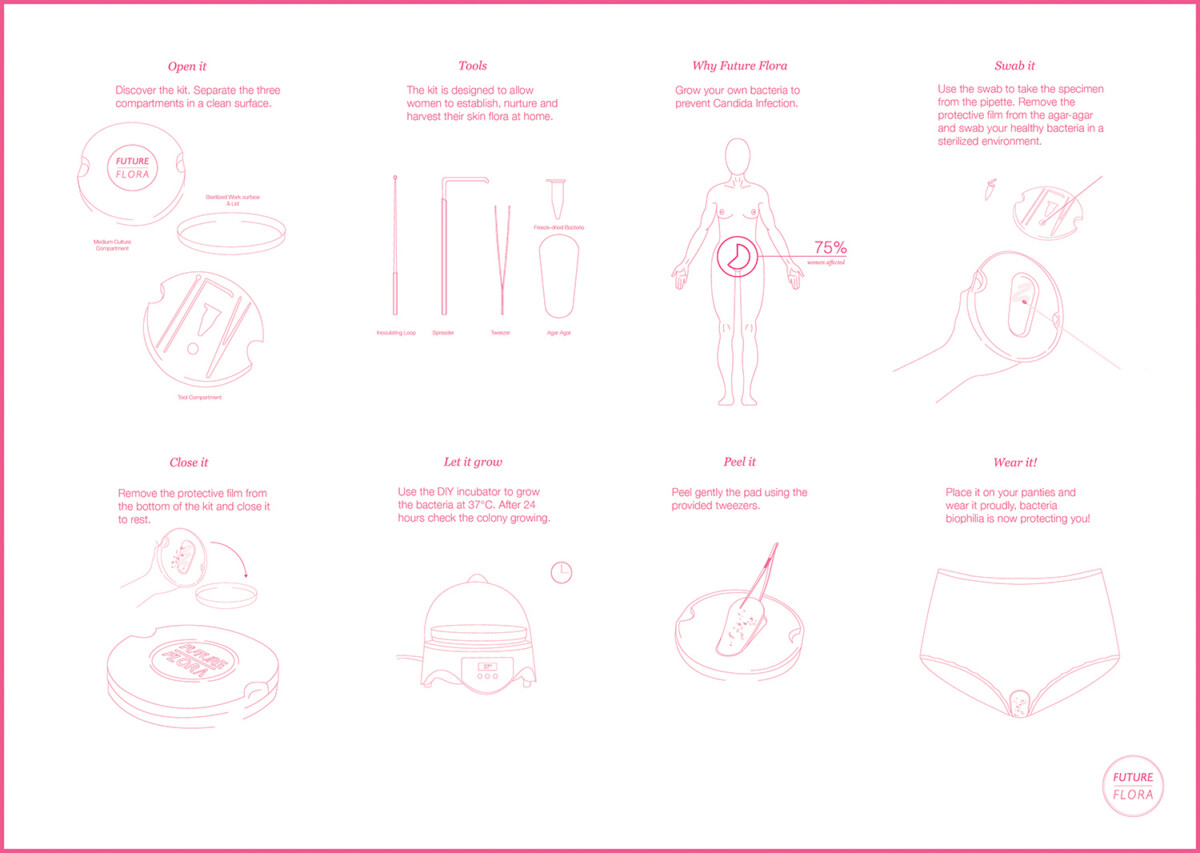 Where the future blossoms
Where the future blossoms
In the case of Future Flora, we talk about artistic exploration of technological potential, but are we really talking about art? Is this distinction important? The issue will not be resolved here, but let us keep it in mind. Created by Giulia Tomasello, a UK-based researcher and interactive designer, Future Flora is a DIY kit that allows women to grow and harvest a microbiome that can prevent or cure vaginal infections. The kit includes the necessary tools to grow a probiotic pad that can then be worn in the underwear. Packaged in such a way as to make it accessible, and even attractive, to take control of one’s health, this product-project becomes the acting symbol of a celebration of female biophilia. This meeting between medicine and health technologies, offered in DIY self-care mode, places the user in a role of active contributor to the development of scientific knowledge in this field.
In addition, Future Flora was presented at the 2018 Starts Prize, where it won the “Grand Prix Exploration artistique”, awarded for a project where “appropriation by the arts can strongly influence or modify the use, deployment or perception of technology”. The Starts Prize is an annual competition and an initiative of the European Commission aimed at fostering “alliances of technology and artistic practice that implement European policymaking to nurture innovation and that benefit the art world as well. The focus is on people and projects that contribute to mastering the social, ecological and economic challenges this continent faces.” The cultural partners of the programme being BOZAR (Brussels, BE), Ars Electronica (Linz, AT) and WAAG Technology & Society (Amsterdam, NL), the results of the competition benefit from these three diffusion windows.
I cannot say whether it was my feminine sensibility that was first called into question, which would have immediately generated a capital of sympathy for the project; or whether it was the ambiguity of the latter that aroused my interest. Because to the question “is it art?” the simple fact of not finding an answer indicates, in my opinion, that there is something to consider and reflect on. It is true that the unclassifiable is often found on the side of contemporary art: the most inclusive cultural field most certainly, always ready to surpass itself and welcome bold proposals that make it jump forward, flirt with the avant-garde and leave us with exclamation and questioning points in our eyes, or stars and confetti, it depends. And this is to its advantage, even if it sometimes leaves us confused and perplexed. These perplexities are signs of a certain health: they tell us that the reflection machine is well underway, that its mechanisms are still working.
When I think of Future Flora I think that its experimental character, its prototype status and its atypical project-product approach place it in the airlock of a purely industrial context, and this airlock is wide open to the artistic world. As long as the project has not exhausted its critical discourse, it will remain in the field of art. What it has to say – much more than what it has to show – gives it a form of artistic belonging. We are here in a new regime of art where the discursive dimension, however conceptual and speculative it may be, takes root in a very concrete and functional material universe. The action suggested by the speech carries within it the real. And this is perhaps one of the qualities of so-called art-science projects: they are rooted in reality, in the possibility of acting on reality. Although these projects are born of a form of speculation, as soon as they approach a shaping, they make contact with tangible reality and take a step aside, outside the range of possibilities – they surreptitiously change regime.
In addition, and as if to support this idea of anchoring in reality, Giulia Tomasello is currently working on Alma, a project parallel to Future Flora. This is a kind of reverse engineering of the first project where portable biosensors are used to monitor and analyze vaginal discharge. By detecting pH and lactic acid from vaginal discharge, it is possible to help diagnose a woman’s gynaecological health status. This project does not follow the speculative traces of research-creation, it is clearly part of an applied science perspective: resulting from the first, it becomes a kind of “product” derived from an initially artistic project.
To be reborn and regain control
As part of the exhibition “Taking Care” (Campus Ars Electronica), the installation Microbiome Rebirth Incubator by François-Joseph Lapointe and Marianne Cloutier was presented. Curated by Anna Kerekes, the exhibition brought together the works of twenty-three artists from the Hexagram network. Taking the form of a scientific research apparatus, with vials and incubator linked together by tubes to circulate liquids, the Lapointe et Cloutier device is shown for what it is: a seeding process for newborns born from emergency cesarean sections that allows them to rebalance their microbiome, unbalanced by the cesarean section. The liquid in question is a probiotic cocktail – amniotic fluid, literally – composed of the mother’s vaginal bacteria and breast milk. The set suggests that the baby could be soaked in the incubator or a sterilized compress soaked in the liquid could be applied to his face and body. As the artists note: “The project symbolically explores the possibility of repairing the microbiome, as a means of restoring power to the mother and child, and erasing the traumatic experience of cesarean birth,” which leaves physiological, biological and psychological scars. In addition to the installation, there is a punctual performative dimension that activates the device. Imitating the “gestures” and codes of medicine, François-Joseph Lapointe and Mary Maggic – also a bio-artist – simulate a medical session to restore the microbiome.
Although speculative, it is nevertheless a very likely project in terms of a scientific process that would restore the biotic balance of newborns by cesarean section. Similar to Giulia Tomasello’s Future Flora, Lapointe et Cloutier’s project talks about empowerment, the possibility of regaining power over one’s own body. In both cases, it is the woman’s case. This is not an insignificant fact when one considers the paternalistic nature of traditional medicine. For a long time the woman’s body did not belong to itself. Interpreted, judged, controlled by men, the sub-beings that once were women – and this, in almost all civilizations, Western or not – then had no right to themselves. Except perhaps the “witches”, who took this right against all odds, and in many cases have paid dearly, at the feet of the pyres. This story with a great H is not so far away – the Middle Ages are yesterday on the scale of the universe. And many cultures still work very hard to suppress women’s rights, legal rights certainly – in a very official way – but also in an insidious and informal way, within their very private lives and intimacy.
In both cases, it is also a question of speculation to educate. By highlighting scientific facts and moving them just a little bit, putting them in quotation marks and juxtaposing them with a related reality that is not the one to which they are immediately associated, we then manage to isolate a significant sequence that applies to itself. We all know that probiotics do us good, but to annex to it the “taboo” imbalances that they can heal, and to do so in a speculative way, by contributing to the construction of an imaginary that can make sensitive those realities that generally remain hidden, we then create a context of reflection that thus becomes a form of education. It works like an epigraph: the sentence extracted from a text that is placed at the very top, that is removed from its context to make it resonate for itself, because alone it says more and differently than between the words upstream and downstream. In the same way, scientific experience that otherwise evolves in a much broader context, and involving various considerations, is circumscribed in order to place it in a gallery or at least outside the scientific or academic environment, and to illuminate it differently in order to view it from new angles.
Beyond these singular angles offered to the viewer, it is the discursive dimension of these projects that is activated by their indeterminate status. To the question is it art or scientific innovation? The answer may lie in triangulation with the public: the work turns to the public, presenting itself as an invitation to reflection, dialogue and, to a certain extent, action. It is a three-step gesture addressed to the individual and also concerns the common good. Art or innovation? Both certainly, and in its movement towards the visitor, it becomes much more.
Get out of the lab
WhiteFeather Hunter‘s Salivam project, in collaboration with researcher Denis Groleau of the Université de Sherbrooke, is moving in the same direction as Future Flora and Microbiome Rebirth Incubator. Managed by Sporobole and developed in the context of a year-long research residency, the result of this research-creation is currently presented in Sporobole’s gallery. Based on bacterial culture techniques, including the isolation and purification of non-pathogenic strains of Bacillus cereus, from soil samples collected from the historic site of the Village des Tanneries in Montreal, and the artist’s saliva. The behaviour of these samples revealed that they were able to produce a powerful enzyme that could digest collagen. The enzymes in question were then extracted and filtered, then used to create sculptural collagen drawings, but also presented as a fake “product”, a satyr of dermatological anti-aging creams that could affect the appearance of the skin.
With the artist’s saliva as the basis of this “product”, it is also a reflection on intimacy that infuses the whole project. The artist also amuses herself by suggesting that licking someone’s face directly would be just as effective in terms of anti-aging treatment – probably even more so – than creams that insist far too much on scientific credibility to assert the effectiveness of their action on our aging skin. Because the enzymes themselves are aging, and there is no indication that the products attractively packaged on our beauty counters are able to do anything other than make us believe in their power. Science, by its hermeticism, relies heavily on its power of credibility and authority. His or her speech usually indicates that something “true” and “verified” will be stated. Not believing it would be bordering on heresy. This is where empowerment and ownership are key. Finding ways to dismantle the scientific hierarchy and build bridges between the research world and the world at large can contribute to the permeability of knowledge.
Like François-Joseph Lapointe, WhiteFeather Hunter has also decided to open up the project to the public, to make it accessible beyond the mere visibility. In the case of Salivam, this is a participatory rather than a performative dimension. A “workstation” has been installed in the diffusion space, adjacent to videos and other sculptural arrangements, objects and scientific artifacts. The public has to manipulate the enzyme by placing a tiny portion in a collagen container in order to identify it and then come back to see the action of one on the other and follow the evolution of this transformation of the material until the end of the exhibition. By appropriating the experience, the public creates a link with a scientific protocol that otherwise remains the inaccessible fact of a closed community. This appropriation in the gallery prefigures the beginning of a more personal appropriation, even in intimacy – as Tomasello’s Future Flora and Lapointe and Cloutier’s Microbiome Rebirth Incubator suggest, in an ideal future. A future where science becomes something that concerns us all, and whose reproducible benefits are reproducible even in our living rooms, kitchens and bathrooms.
Relocated, from the laboratory to the space of artistic diffusion, the project is embodied in objects and videos, is put into space, settles down and shows itself to be seen. By moving from the lab’s exclusive discretion to the gallery’s public visibility, the research process and scientific experience somehow transgresses its usual, private and privileged posture. If research such as that of WhiteFeather Hunter, Giulia Tomasello, François-Joseph Lapointe and Marianne Cloutier reaches us through art, it is because their approach is clearly transversal and also tends towards a certain horizontality in terms of scientific hierarchy. Transversality makes it possible to cross the closed spaces of certain disciplines; the performative/participative aspect also: getting out of inertia is a necessary condition for undermining what is considered established.
–
One of the characteristics of bio-art is to make the invisible visible. What is happening in our bodies is rarely visible to the naked eye: we are most often in the micro reality of the biological. And not only do we not see what is going on, but we do not always feel it. In this world of the indistinguishable, it is part of our access to ourselves that escapes us. There is nothing new in these facts. What is new, however, is this desire to appropriate processes and protocols, to break with a hermetic scientific tradition, to touch and manipulate materials and micro-organisms, to improvise and express intuitions, to create gaps to let air and light through. Do not forget that it is thanks to the latter that the things of the world are visible to us.
Nathalie Bachand
Image (top): Microscope – photo by Pawel Czerwinski (unsplash.com).
Future Flora of Giulia Tomasello: 1) Tom Mannion 2-6) Giulia Tomasello.
Images Microbiome Rebirth Incubator by François-Joseph Lapointe and Marianne Cloutier: Ars Electronica, vog.photo.
Images of WhiteFeather Hunter’s exhibition at Sporobole: Tanya St-Pierre.
Translated with www.DeepL.com/Translator
